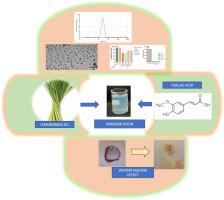从Cymbopagan citratus中提取的柠檬草油 (LMGO)具有抗菌和抗氧化特性。阿魏酸 (FA) 是一种天然抗氧化剂,是一种存在于蔬菜、水果中的血管生成剂,具有有效的抗炎活性,有助于伤口愈合过程。本研究的目的是通过相转化组合法配制和优化负载 FA 的 LMGO 纳米乳液 (NE),该方法尚未通过 Box Behnken 设计 (BBD) 进行充分探索。结合常规伪三元相图评价表面活性剂混合物(S mix)的表面活性参数,以选择S混合比例。表面活性参数包括临界胶束浓度(CMC)、表面过量浓度(Гmax)、表面活性剂分子吸附的最小表面积(A min)、吸附有效性(Π cmc)以及胶束化和吸附的吉布斯热力学参数。采用 BBD 通过研究四个自变量(包括油 (X 1 )、表面活性剂混合物 (X 2 )、搅拌速度 (X 3 ) 和搅拌时间 (X 4 ))对三种响应的相互作用影响来优化配方,例如、平均液滴尺寸 (Y 1 )、多分散指数 (PDI) (Y 2 ) 和百分比透射率 (Y 3 )。在最佳变量水平 (X 1 = 10 %; X2 = 30%; X 3 = 500 rpm 和 X 4 = 5 分钟),Y 1、Y 2、Y 3的响应分别为 26.15 ± 0.58 nm、0.04 ± 0.01 和 99.76 ± 0.06%, 分别。优化后的 NE 用水稀释 5、10 和 100 倍时,在液滴尺寸、PDI、百分比透射率和表面张力方面表现出稳定性。这些发现可能有助于用低能量方法设计具有更高动力学稳定性的 NE,用于治疗应用。测定FA含量为98.11±0.51%。将优化的 FA 负载 NE (FLGO) 与 2% carbopol®940 混合,用于开发纳米乳胶。开发的 FA 负载纳米乳液 (FLGO-G) 系统表现出假塑性行为,适合局部应用。空白柠檬草油纳米乳液负载凝胶 (LGO-G) 和 FLOG-G 制剂显示出 52.82 ± 0.33% 和 75.62 ± 0.16% 的 DPPH 自由基抑制百分比。该制剂还表现出针对金黄色葡萄球菌的体外抗菌活性。在雄性Wistar大鼠体内研究了LGO-G和FLGO-G的体内伤口愈合功效,IL-6和TNF-α水平有较大程度的降低。
 "点击查看英文标题和摘要"
"点击查看英文标题和摘要"
Multimodal lemongrass oil based topical nanoemulgel ingrained with ferulic acid for wound healing activity
The lemongrass oil (LMGO) obtained from Cymbopagan citratus betrays anti-bacterial and anti-oxidant properties. A natural anti-oxidant, ferulic acid (FA) is an angiogenic agent found in vegetables, fruits exhibiting potent anti-inflammatory activity aiding in wound healing process. This investigation was aimed to formulation and optimization of the FA loaded LMGO nanoemulsion (NE) by phase inversion composition method, that has not been well explored by using Box Behnken design (BBD). The surface-active parameters of surfactant mixture (Smix) were evaluated for the selection of Smix ratio in conjunction with conventional pseudo ternary phase diagram. The surface-active parameters included critical micelle concentration (CMC), surface excess concentration (Гmax), minimum surface area adsorbed by surfactant molecules (Amin), effectiveness of adsorption (Πcmc) along with Gibbs thermodynamic parameters for micellization and adsorption. The BBD was employed to optimize the formulation by studying the interaction effects of four independent variables including oil (X1), surfactant mixture (X2), stirring speed (X3), and stirring time (X4) on three responses such as, mean droplet size (Y1), polydispersity index (PDI) (Y2) and percentage transmittance (Y3). At the optimal variable levels (X1 = 10 %; X2 = 30%; X3 = 500 rpm and X4 = 5 min), the responses were found to be 26.15 ± 0.58 nm, 0.04 ± 0.01 and 99.76 ± 0.06% for Y1, Y2, Y 3, respectively. The optimized NE exhibited stability in terms of droplet size, PDI, percentage transmittance and surface tension on 5, 10 and 100 times dilution with water. These findings may be useful for designing NE with low energy methods with greater kinetic stability for therapeutic applications. The FA content was determined and found be 98.11 ± 0.51%. The optimized FA loaded NE (FLGO) was incorporated with 2% carbopol®940 for the development of nanoemulgel. The developed FA loaded nanoemulgel (FLGO-G) system demonstrated the pseudoplastic behaviour, desirable for topical application. The blank lemongrass oil nanoemulsion loaded gel (LGO-G) and FLOG-G formulation showed 52.82 ± 0.33% and 75.62 ± 0.16% of DPPH free radical % inhibition. The formulations also showed in-vitro antibacterial activity against S. aureus. The in vivo wound healing efficacy of LGO-G and FLGO-G were studied in male wistar rat, the levels of IL-6 and TNF-α reduced to greater extent.



































 京公网安备 11010802027423号
京公网安备 11010802027423号